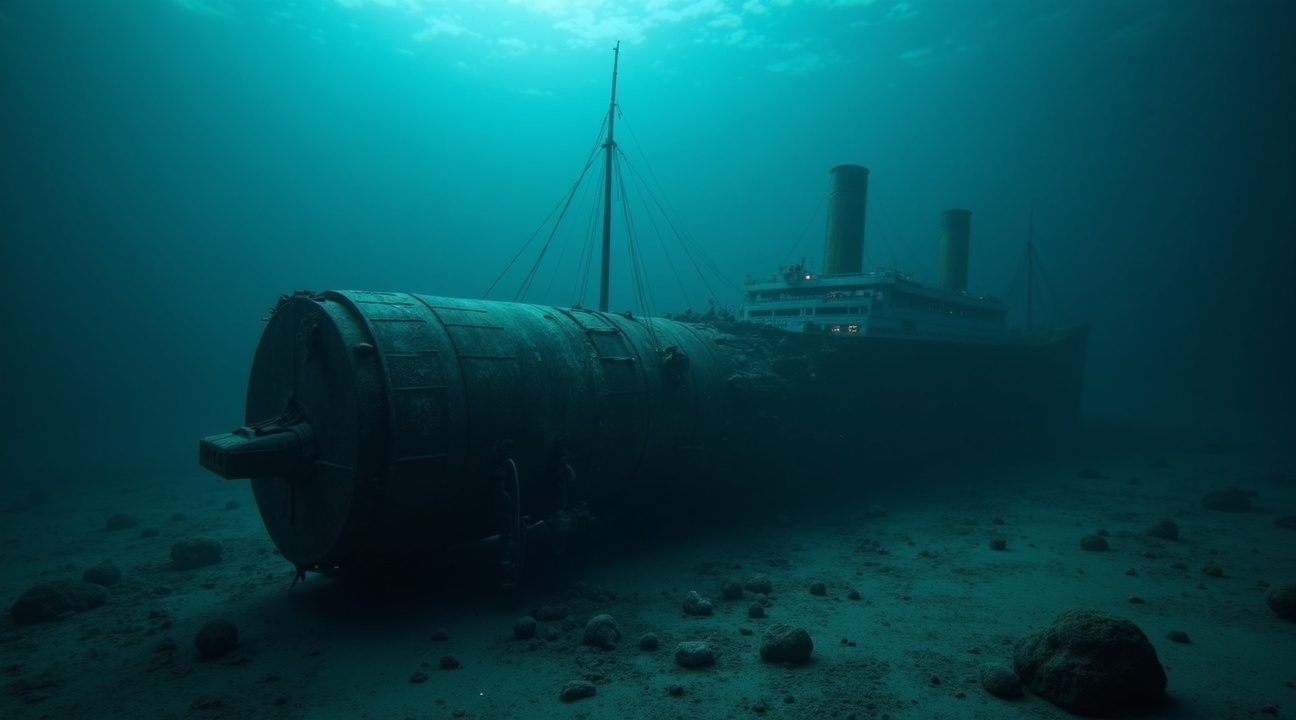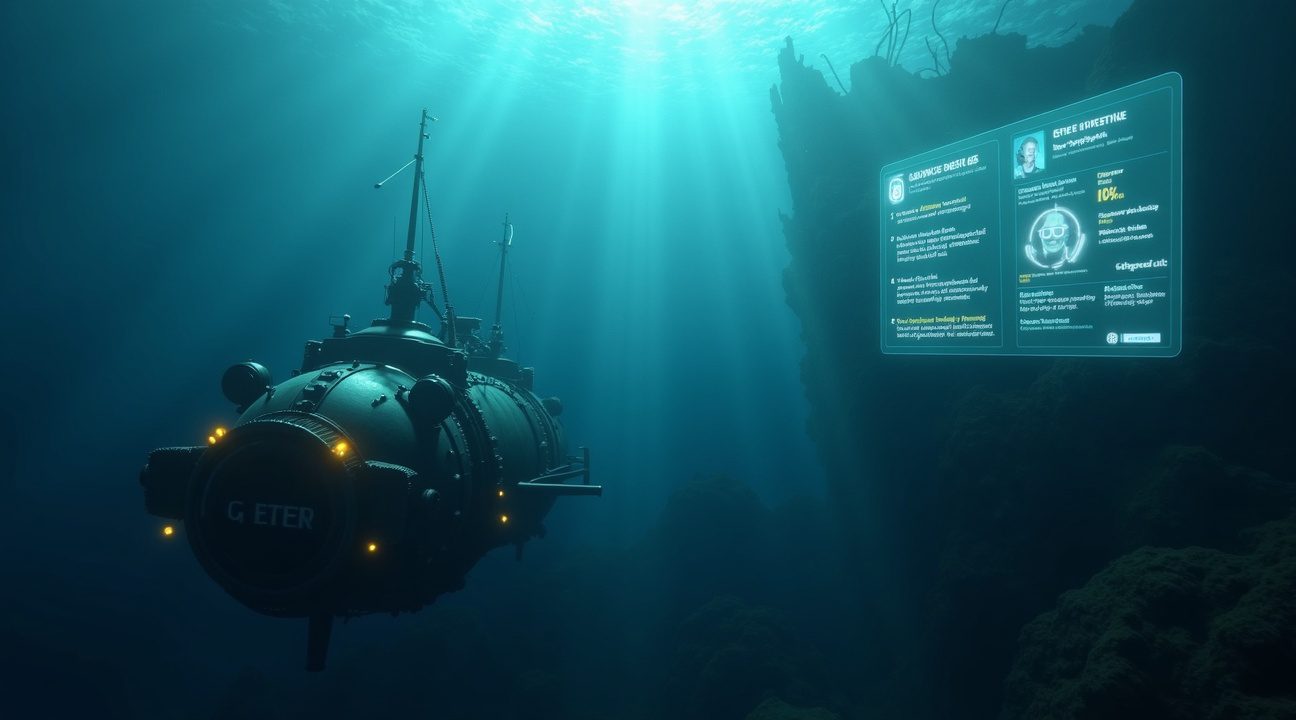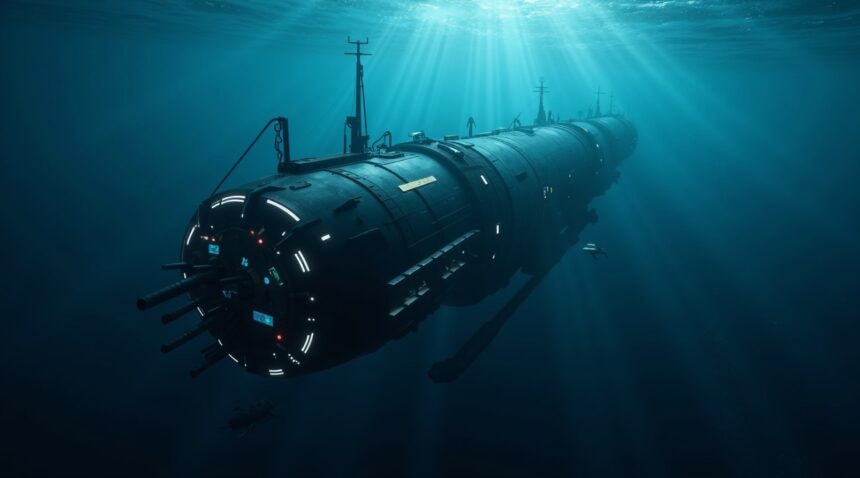Following the tragic Titan submersible implosion that claimed five lives, a prominent billionaire has announced plans to build an entirely new deep-sea exploration vessel specifically designed to visit the Titanic wreckage.
This ambitious project directly addresses the safety failures that led to the disaster, promising a fundamentally different approach to deep-ocean exploration that prioritizes proven engineering principles over experimental designs.
Key Takeaways
- The new submersible will use extensively tested materials like titanium alloys instead of the experimental carbon fiber design that failed catastrophically in the Titan disaster.
- Mandatory third-party certification and rigorous regulatory compliance will replace the self-certification approach that allowed OceanGate to operate without proper oversight.
- Real-time hull integrity monitoring systems with multiple redundancies will continuously track structural stress, material fatigue, and pressure differentials throughout each dive.
- The project timeline suggests operational capability within three to five years, pending successful completion of extensive testing phases and approval from international maritime authorities.
- Industry-wide regulations now require comprehensive safety protocols, maintenance audits, and emergency response capabilities that exceed previous standards for deep-sea tourism operations.
Engineering Principles: A New Direction
The engineering philosophy behind this new venture represents a complete departure from OceanGate’s experimental approach. Traditional materials like steel and titanium alloys form the foundation of the design. These materials have undergone decades of testing in extreme environments. Carbon fiber composites, while excellent for aerospace applications, proved inadequate for repeated deep-sea pressure cycles.
Third-Party Certification and Oversight
Safety certification takes center stage in this project. Independent marine classification societies will oversee every aspect of construction and testing. The Titan submersible operated under an experimental designation that bypassed standard safety requirements. This new vessel will meet or exceed all existing commercial submarine standards before carrying passengers.
Continuous Structural Monitoring
Structural monitoring systems will provide continuous feedback during operations. Strain gauges embedded throughout the hull will measure stress levels in real-time. Acoustic sensors will detect any signs of material degradation or crack formation. Multiple backup systems ensure continued monitoring even if primary sensors fail.
Development Timeline
The timeline reflects the complexity of proper submarine development. Initial design phases will consume approximately 18 months. Construction and systems integration require another 24 months minimum. Extensive testing protocols, including multiple unmanned deep dives, will validate all safety systems before human trials begin.
Tighter Regulatory Controls
Regulatory approval processes have become significantly more stringent since the Titan incident. International maritime organizations now demand comprehensive documentation of all safety systems. Emergency response protocols must demonstrate rapid reaction capabilities for rescue operations at extreme depths. Communication systems require multiple redundant pathways to maintain contact throughout each dive.
A Maturing Industry
This project signals a maturation of the deep-sea tourism industry. The tragic loss of life aboard Titan highlighted the dangers of cutting corners in submarine design. Engineering principles that govern commercial submarine construction cannot be compromised for cost savings or schedule acceleration. The ocean’s extreme environment demands absolute respect for proven safety practices.
Billionaire Announces Revolutionary Submersible Project After Titan Disaster
Following the tragic Titanic submersible implosion that claimed five lives, a prominent billionaire has stepped forward with plans to build an entirely new deep-sea exploration vessel. This ambitious project directly addresses the safety failures that led to the Titan disaster, promising a fundamentally different approach to deep-ocean exploration.
Safety-First Engineering Philosophy
The new submersible project prioritizes proven engineering principles over experimental approaches. Unlike OceanGate’s controversial carbon fiber design, this initiative will utilize extensively tested materials with established track records in extreme pressure environments. The billionaire’s team plans to implement rigorous third-party certification processes, working closely with international regulatory bodies from the design phase through operational deployment.
Real-time hull integrity monitoring represents a cornerstone of the safety strategy. Advanced sensor networks will continuously track structural stress, material fatigue, and pressure differentials throughout each dive. This monitoring system contrasts sharply with the limited safety features that contributed to concerns about OceanGate’s operational approach.
Next-Generation Technology Integration
The revolutionary submersible will incorporate cutting-edge technology designed specifically for deep-ocean exploration. Key innovations include:
- Multi-redundant life support systems with backup power sources
- Advanced communication arrays for continuous surface contact
- Emergency ascent mechanisms independent of primary propulsion
- Reinforced viewing systems using proven materials and designs
- Automated safety protocols that can override human decision-making
The project explicitly seeks to restore confidence in deep-sea tourism while honoring the legacy of those lost in the Titan incident. By embracing traditional submarine engineering principles rather than pushing untested boundaries, the billionaire aims to create a vessel worthy of exploring the famous wreck site safely.
This initiative represents more than just technological advancement—it embodies a commitment to learning from past mistakes. The billionaire’s team has studied the factors that led to rescue complications during the Titan crisis, incorporating lessons about emergency response capabilities and communication protocols into their design philosophy.
The submersible project timeline suggests operational capability within three to five years, pending successful completion of extensive testing phases and regulatory approval processes.
The Titan Tragedy That Changed Everything
I’ll examine the catastrophic event that fundamentally altered how the deep-sea exploration industry approaches submersible safety and regulation. The OceanGate Titan disaster stands as one of the most significant maritime tragedies in recent history, exposing critical flaws in submersible design and oversight.
The Fatal Descent
The Titan submersible imploded on June 18, 2023, claiming the lives of all five occupants during what should have been a routine tourist expedition to the Titanic wreckage. CEO Stockton Rush, explorer Hamish Harding, veteran French diver Paul-Henri Nargeolet, businessman Shahzada Dawood, and his son Suleman perished when the vessel suffered catastrophic failure approximately 90 minutes into the dive.
The implosion occurred at a depth targeting roughly 3,800 meters (12,500 feet) in the North Atlantic, placing the crew perilously close to their intended destination. This timing proved particularly tragic, as the passengers likely believed they were nearing the historic wreck site when disaster struck. The sudden nature of the structural failure meant the occupants experienced instantaneous death, according to maritime experts who analyzed the incident.
Investigation Reveals Systemic Failures
The final Marine Board of Investigation report, released on August 5, 2025, by the U.S. Coast Guard, painted a damning picture of OceanGate’s operational practices. I’ve reviewed these findings extensively, and they reveal a pattern of negligence that made tragedy inevitable.
The investigation identified several critical factors that contributed to the disaster:
- Inadequate design specifications that failed to account for the extreme pressures at Titanic depths
- Insufficient certification processes that bypassed standard maritime safety protocols
- Poor maintenance practices that compromised the vessel’s structural integrity over time
- Lack of meaningful hull material analysis that could have identified potential failure points
- Absence of proper regulatory oversight that might have prevented the submersible from operating
The report particularly criticized OceanGate’s decision to use unconventional materials and construction methods without adequate testing. The owner’s admitted fears about submersion proved prophetic, as the company’s cost-cutting measures and regulatory avoidance ultimately sealed the fate of everyone aboard.
The investigation also highlighted how rescue efforts intensified as the submersible remained missing, with multiple nations coordinating search operations across the North Atlantic. However, by the time rescue teams located debris from the vessel, it became clear that the implosion had occurred much earlier in the dive sequence.
This tragedy stands in stark contrast to the Titanic itself, which didn’t implode during its descent to the ocean floor in 1912. The differences in structural failure modes between the two vessels highlight how improper modern engineering can prove more dangerous than century-old ship construction when subjected to extreme deep-sea conditions.
The Titan disaster has fundamentally changed how the submersible industry approaches safety certification and design standards. New regulations now require:
- Extensive testing protocols under realistic deep-sea conditions
- Mandatory third-party inspections of all safety-critical systems
- Comprehensive material analysis including carbon fiber and pressure hull testing
Before any deep-sea vessel can carry passengers to such extreme depths, it must comply with these stringent guidelines, in hopes of preventing another tragedy of the same magnitude.

Revolutionary Safety Features That Will Prevent Another Disaster
The billionaire’s new submersible project represents a complete departure from the flawed design choices that led to the Titanic submersible implosion. Every aspect of this vessel prioritizes proven safety protocols over experimental approaches that cost five lives during the tragic Titan incident.
Advanced Hull Construction and Materials
The most critical improvement centers on hull construction materials. OceanGate’s Titan submersible relied on carbon fiber composite for its pressure vessel, which proved catastrophically inadequate for extreme deep-sea conditions. Carbon fiber, while lightweight and strong in many applications, exhibits unpredictable failure patterns under the immense pressures found at Titanic’s depth of 12,500 feet.
The new submersible will utilize advanced titanium alloys or pressure-rated steel composites that represent industry standards for deep-ocean exploration. These materials have undergone decades of testing and validation in similar extreme environments.
- Titanium alloys offer exceptional strength-to-weight ratios while maintaining predictable failure characteristics that allow for proper safety margins.
- Unlike carbon fiber’s tendency toward sudden, catastrophic failure, these proven materials provide warning signs before reaching critical stress levels.
Comprehensive Certification and Monitoring Systems
Regulatory oversight represents another fundamental shift from Titan’s approach. OceanGate deliberately avoided third-party certification, claiming their innovative design couldn’t be properly evaluated by existing standards. This decision eliminated crucial safety checks that might have identified structural weaknesses before they became fatal.
The new project will undergo full certification through recognized maritime authorities and independent testing organizations. Every component, from life support systems to structural elements, will face rigorous evaluation by experts who understand deep-sea engineering challenges.
- Pressure testing far beyond operational requirements
- Comprehensive failure mode analysis
Real-time monitoring systems will replace Titan’s custom-built approach with industry-validated technology. The original vessel used experimental acoustic monitoring that failed to provide adequate warning of structural degradation.
Professional-grade structural health monitoring systems will:
- Continuously track hull integrity, pressure differentials, and material stress patterns
- Integrate multiple sensor types and provide redundant data streams
- Ensure early detection of any anomalies
Enhanced maintenance protocols address another critical failure point from the Titan program. OceanGate’s maintenance practices lacked proper documentation and independent oversight, allowing potential problems to go undetected.
The new submersible will follow scheduled maintenance procedures developed specifically for deep-sea vehicles, with every inspection and repair verified by certified technicians.
Third-party audits will occur regularly, ensuring maintenance standards remain consistent and thorough. These audits examine:
- The physical condition of equipment
- The procedures and documentation supporting safe operations
Independent oversight eliminates the potential for corners to be cut or safety protocols to be compromised under operational pressure.
Operational oversight represents the final layer of improved safety measures. The new project will comply fully with international safety guidelines established by organizations with decades of deep-sea exploration experience.
This compliance covers:
- Crew training
- Emergency procedures
- Communication protocols
- Operational safety limits
The contrast with Titan’s minimal regulatory involvement couldn’t be more stark. Where OceanGate operated largely outside established safety frameworks, this new venture embraces proven standards that have protected countless deep-sea missions.
International guidelines exist precisely because they incorporate lessons learned from decades of underwater exploration, including both successes and failures that shaped current best practices.
These comprehensive safety improvements create multiple layers of protection that work together to prevent another disaster. Each system provides redundancy for the others, ensuring that no single point of failure can compromise passenger safety during visits to the Titanic wreckage.
New Regulations Born From Tragedy
The catastrophic loss of the Titan submersible sparked immediate demands for comprehensive regulatory reform across the deep-sea exploration industry. I’ve observed how the tragedy exposed critical gaps in oversight that had allowed experimental vessels to operate without adequate safety verification. The incident served as a wake-up call that prompted international maritime authorities to develop stricter standards for submersible operations.
Mandatory Certification Requirements
Investigations following the Titan disaster produced specific recommendations that address fundamental safety oversights. These new protocols require mandatory external certification for hull integrity, ensuring that independent experts validate structural designs before any vessel descends to extreme depths. The certification process now demands rigorous testing of pressure vessels and comprehensive documentation of all materials used in construction.
Regular maintenance audits have become another cornerstone of the emerging regulatory framework. These audits must occur at specified intervals and include detailed inspections of life support systems, communication equipment, and emergency protocols. I find these requirements particularly crucial given that the Titanic submersible incident highlighted how inadequate maintenance oversight can lead to catastrophic failures.
The new standards also establish explicit operational protocols that cover everything from crew training requirements to passenger safety briefings. These protocols address the regulatory gaps that previously allowed experimental submersibles to operate with minimal oversight, particularly in international waters where jurisdiction often remained unclear.
Industry-Wide Safety Transformation
The billionaire-led project planning to visit the Titanic wreckage has committed to exceeding these evolving safety standards. This commitment represents a significant shift from the experimental approach that characterized earlier deep-sea tourism ventures. The new vessel’s design process incorporates lessons learned from the Titan tragedy, with particular attention to structural integrity and emergency response capabilities.
International maritime organizations have begun coordinating their efforts to create unified submersible certification standards. These standards address accident prevention through comprehensive risk assessment protocols and require detailed emergency response plans for every mission. The regulatory framework now demands that operators demonstrate their ability to handle various emergency scenarios before receiving operational approval.
I’ve noticed that these regulations extend beyond technical specifications to include operator accountability measures. Companies must now maintain comprehensive insurance coverage and establish clear liability frameworks that protect passengers while ensuring operators take responsibility for safety compliance. The submarine owner’s concerns about submersion risks underscore why these accountability measures have become essential components of the new regulatory landscape.
The industry standards now require real-time monitoring systems that can track vessel location, depth, and critical system status throughout missions. These monitoring requirements ensure that surface support teams maintain constant communication with submersibles and can coordinate rescue operations if emergencies arise. The rescue challenges experienced during the Titan incident demonstrated how communication failures can complicate emergency response efforts.
Safety recommendations also mandate that all submersible operators establish partnerships with certified rescue organizations before beginning operations. These partnerships ensure that appropriate rescue equipment and expertise remain readily available during missions to extreme depths. The new regulatory framework recognizes that effective emergency response requires specialized equipment and training that most tourism operators can’t maintain independently.
The evolving standards create a comprehensive approach to submersible safety that addresses technical, operational, and emergency response requirements. This regulatory transformation aims to prevent future tragedies while enabling continued exploration of sites like the Titanic wreckage under much safer conditions than those that existed during the Titan era.
Industry Transformation and Public Demands for Change
The extensive media coverage surrounding the Titanic submersible implosion has sparked unprecedented public demands for accountability and transparency within the extreme underwater tourism sector. I observe that citizens, families of victims, and safety advocates now call for immediate implementation of stricter regulations and oversight mechanisms. The tragedy has exposed significant gaps in current industry practices, prompting widespread criticism of self-certification processes and inadequate safety protocols.
Aerospace-Level Standards Drive Reform
Industry experts consistently emphasize that adopting aerospace-level certification and monitoring standards represents the only viable path forward for underwater tourism operations. Aviation’s rigorous testing procedures, comprehensive documentation requirements, and independent oversight models provide a proven framework that can restore public confidence. I note that several prominent marine engineers have publicly stated that current submersible regulations lack the depth and precision found in aircraft certification processes.
The transformation extends beyond technical specifications to encompass operational transparency. Public reaction has been overwhelmingly critical of companies that operate without independent safety audits or refuse to disclose detailed technical specifications. Rescue operation challenges further highlighted the need for real-time monitoring systems and emergency response protocols that match the sophistication of modern aviation standards.
Regulatory Authority Response and Future Changes
Regulatory authorities across multiple jurisdictions have announced comprehensive reviews of existing underwater tourism frameworks. Proposed changes include:
- Mandatory third-party inspections
- Standardized emergency communication systems
- Enhanced passenger safety briefings that clearly outline risks and limitations
I find that these regulatory responses directly address public concerns about operator accountability and passenger protection.
Commentary from past expedition participants reveals growing support for increased regulation, even if it means higher costs and longer development timelines. Many former customers now advocate for technology improvements that prioritize safety over expedition scheduling or cost considerations. The sector faces pressure to implement:
- Real-time depth monitoring
- Redundant communication systems
- Enhanced structural testing protocols that exceed current minimum requirements
The transformation demands that operators embrace transparency as a core business principle rather than viewing safety disclosures as competitive disadvantages. Public trust can only be rebuilt through demonstrated commitment to rigorous standards and open communication about both capabilities and limitations in deep-sea exploration technology.

Sources:
ABC News: “Coast Guard OceanGate Titan Submersible Report Critical of CEO’s Safety Practices”
Wikipedia: “Titan Submersible Implosion”
Encyclopaedia Britannica: “Titan Submersible Implosion | Date, Cause, OceanGate, Location, Timeline, Deaths, & Map”
BBC News Documentary: “Titan Submersible Footage Captures Moment of Implosion”


